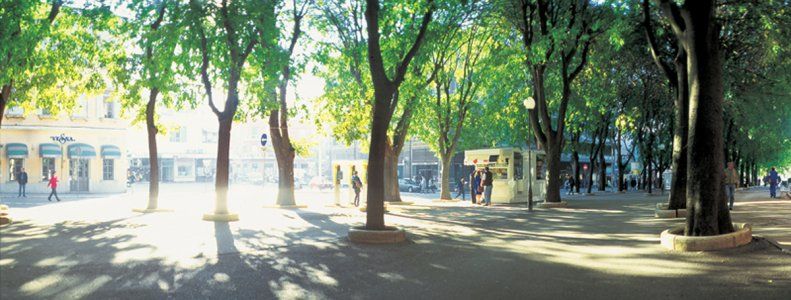Giardini
In the second half of the 19th century, in the area beneath the old Kaštel, a park was designed. Paths were built, flowerbeds arranged, grass sown, trees planted. The area was later transformed into a marketplace. In the beginning of the 20th century some hundred hackberry trees were planted in four rows that even nowadays offer shade to the citizens of Pula and chance-travelers. The old photograph shows that the planted trees were properly raised in one of the then nurseries with a very finely developed crown and straight trunk. All seedlings were of the same habitus. Some of them did not stand the test of time, so that only eighty have remained until the present being the most precious green oasis in the heart of the city. The trees are a silent witness of changes of government, culture and generations in Pula. Nowadays they are about twenty meters high.
From the vast promenade the stairs led to the City museum. They were at the same time a communication of the city, extending beyond the city walls, with the old core of Kaštel. Since Pula had a streetcar communication from one side of the city to another during the Austro-Hungarian rule, one of the city lines led along Giardini.
Beside the road and along the promenade there were streetlights giving a romantic atmosphere. East of Giardini is the Roman monument – the Triumphal Arch of the Sergi, one of the points of interest on a sightseeing tour of the city and the reason why there are so many people at Giardini. In the deep shade of the trees the caterers have spread out their cafés so that you can have a drink enjoying the murmur of tiny leaves.
Throughout its history Giardini was the meeting place and site of various events. Already in the first half of the 20th century book fairs and occasional sales were held here. This tradition continued even later so that it was the site of film projections, concerts and other social events. “Korzo”, as the promenade was named after the War, thus became the main social gathering place. The photograph from the beginning of the century still shows the green belt between the line of trees and the upper road, which was all that remained from the previous gardens. That belt was greatly reduced during the bombing in World War II. After the War, remains of the city walls were found and reconstructed. Archaeological excavation around the Triumphal Arch of the Sergi in 1995 removed the last remains of greenery. The beautiful holm oak planted at the beginning of the century was pulled down, as well as the hedge of bitter orange (Poncirus trifoliatus), the only example in Pula. Presently, apart from the canal, Giardini is separated from the old city walls of Kaštel, by a hedge of firethorn (Pyracantha coccinea).

